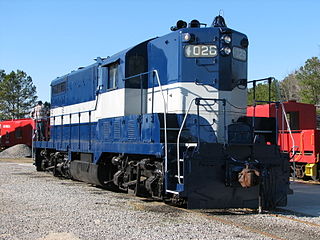
U.S. Route 82 is an east–west United States highway in the Southern United States. Created on July 1, 1931 across central Mississippi and southern Arkansas, US 82 eventually became a 1,625-mile (2,615 km) route extending from the White Sands of New Mexico to Georgia's Atlantic coast.
The Alabama Midland Railway was incorporated in Alabama and Georgia in 1887, and built a line from Bainbridge, Georgia, to a point near Montgomery, Alabama. The route was completed in 1890. It became part of the Plant System in 1894, and in 1901 it was merged into the Savannah, Florida and Western Railway.

The Georgia Railroad and Banking Company also seen as "GARR", was a historic railroad and banking company that operated in the U.S. state of Georgia. In 1967 it reported 833 million revenue-ton-miles of freight and 3 million passenger-miles; at the end of the year it operated 331 miles (533 km) of road and 510 miles (820 km) of track.

The Plant System named after its owner, Henry B. Plant, was a system of railroads and steamboats in the U.S. South, taken over by the Atlantic Coast Line Railroad in 1902. The original line of the system was the Savannah, Florida and Western Railway, running across southern Georgia. The Plant Investment Company was formed in 1882 to lease and buy other railroads and expand the system. Other major lines incorporated into the system include the Savannah and Charleston Railroad and the Brunswick and Western Railroad.

The Central of Georgia Railway started as the Central Rail Road and Canal Company in 1833. As a way to better attract investment capital, the railroad changed its name to Central Rail Road and Banking Company of Georgia. This railroad was constructed to join the Macon and Western Railroad at Macon, Georgia, and run to Savannah. This created a rail link from Chattanooga, on the Tennessee River, to seaports on the Atlantic Ocean. It took from 1837 to 1843 to build the railroad from Savannah to the eastern bank of the Ocmulgee River at Macon; a bridge into the city was not built until 1851.

The Georgia Southwestern Railroad is a Class III short line railroad company that operates over 234 miles (377 km) of track in southwestern Georgia and southeastern Alabama. Beginning in 1989 as a division of the South Carolina Central Railroad on a pair of former CSX Transportation lines, the railroad has since undergone a number of transformations through abandonments and acquisitions before arriving at its current form. The railroad was formerly a RailAmerica property before going independent, and in 2008 it was acquired by Genesee & Wyoming Inc.
The Chattanooga, Rome and Columbus Railroad (CR&C) was a railroad in Georgia.
The Charleston and Western Carolina Railway (C&WC) was formed in 1896 to operate the lines of the former Port Royal and Augusta Railway (PR&A) and the Port Royal and Western Carolina Railway (PR&WC). The PR&A and PR&WC had originally been part of the Central of Georgia Railroad but the South Carolina Legislature had forced the railroad to give up the subsidiary lines. The Atlantic Coast Line Railroad (ACL) took over the C&WC in 1897 but operated it as a subsidiary until 1959 when the ACL fully absorbed it. Much of the original system is still in use by ACL successor CSX Transportation.
The Columbus and Rome Railway is a historic, 3 ft narrow gauge railroad that operated in the U.S. state of Georgia.
The Columbus and Western Railway (C&W) is a historic railroad that operated in Georgia, United States.

The Heart of Georgia Railroad is a shortline railroad created in 1999 to lease and operate 177 miles (285 km) of track owned by the Georgia Department of Transportation between Mahrt, Alabama and Vidalia, Georgia, in the United States. The railroad has since expanded to include more than 219 miles (352 km) of track, reaching as far as Midville, Georgia. Initially only the portion from Rochelle to Preston, Georgia was utilized, with the Preston-Mahrt and Rochelle-Vidalia lines out of service. The Heart of Georgia also hosts the SAM passenger excursion train and is owned by parent company Atlantic Western Transportation Company.

The East Tennessee, Virginia and Georgia Railroad (ETV&G) was a rail transport system that operated in the southeastern United States during the late 19th century. Created with the consolidation of the East Tennessee and Virginia Railroad and the East Tennessee and Georgia Railroad in 1869, the ETV&G played an important role in connecting East Tennessee and other isolated parts of Southern Appalachia with the rest of the country, and helped make Knoxville one of the region's major wholesaling centers. In 1894, the ETV&G merged with the Richmond and Danville Railroad to form the Southern Railway.
Georgia Southern Railroad Company was incorporated under act of the Georgia General Assembly on March 2, 1875. The line of railroad of the Selma, Rome and Dalton Railroad Company in Georgia was sold in foreclosure on November 3, 1874 and conveyed to Georgia Southern Railroad Company on March 29, 1876. Georgia Southern Railroad Company was sold to East Tennessee, Virginia and Georgia Railroad Company on November 6, 1880.
The original Georgia and Alabama Railroad was based in Rome, GA, incorporated in 1853, and started initial rail construction in 1857. In August 1866, the G&A officially consolidated with the Dalton and Jacksonville Railroad and the Alabama and Tennessee River Railroad Company with the intent to create a consolidated rail system from Selma, AL to Dalton, GA. The consolidated corporation was to do business under the name of the latter, but it officially took the name Selma, Rome and Dalton Railroad Company in December of that same year. Still, in some cases, business continued under the name of Georgia and Alabama Railroad. For instance, in May 1868, a contract was executed to the Georgia and Alabama Railroad, leasing 100 African American convicts in the state of Georgia to work for the railroad company without pay.

The Mobile & Girard Railroad was an Alabama railroad which was constructed in the mid-19th century; a portion of the line continues in operation under different ownership. The 26-mile (42 km) line was constructed with a track gauge of 5 ft.
Alabama and Tennessee River Rail Road Company was incorporated under act of Alabama on March 4, 1848. With John Anderson Dilliard being principal shareholder. J. A. Dilliard a LaGrange, Tennessee, native originally from Decatur, AL was also a principal owner in the Lagrange and Memphis Railroad which became the Memphis and Charleston Railroad, along with Joseph Dilliard and H.B. Dilliard.

Selma, Rome and Dalton Railroad Company was formed by the consolidation of Alabama and Tennessee River Rail Road Company, Georgia and Alabama Rail Road Company and Dalton and Jacksonville Railroad Company on August 6, 1866. The consolidation agreement was ratified by the Georgia General Assembly on December 13, 1866 and by the Alabama Legislature on February 8, 1867.








